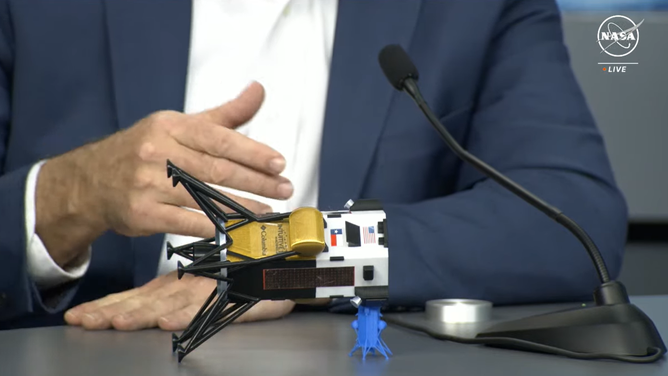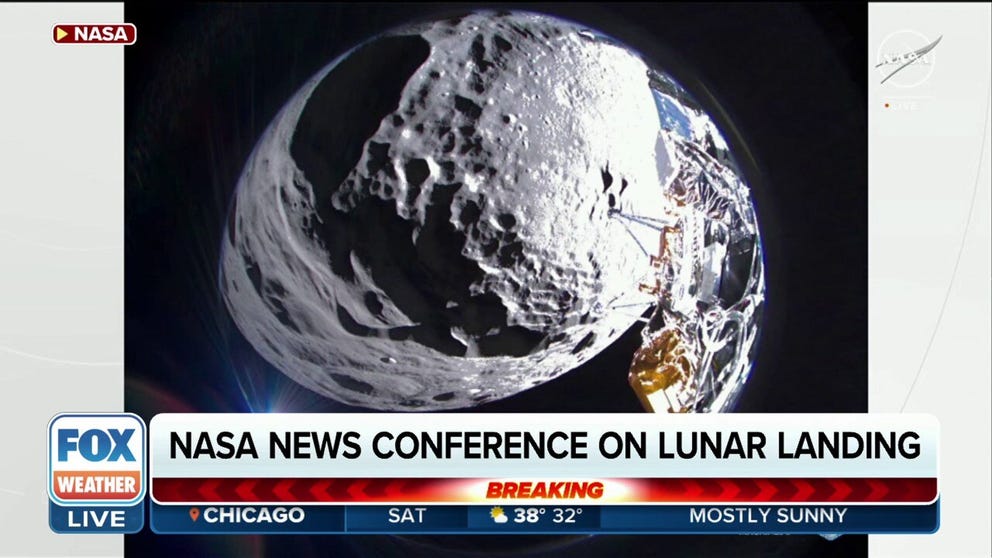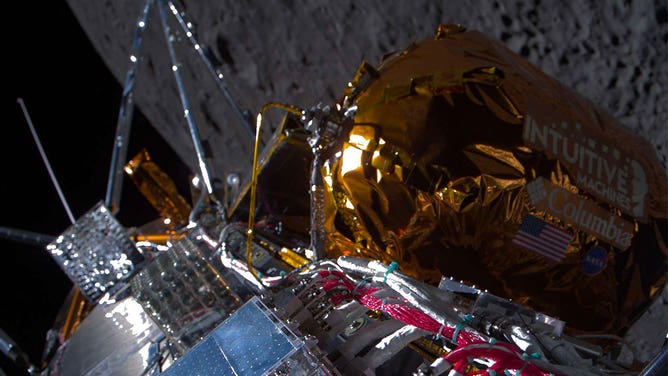New image from Moon lander revealed but questions remain whether we'll see photos from lunar surface
The IM-1 mission launched from the Kennedy Space Center on Feb. 15 and landed on the Moon’s South Pole on Feb. 22. NASA said instruments and technology onboard the Intuitive Machines lander will help pave the way for human missions to the Moon.
NASA, Intuitive Machines provide update on Moon lander
Officials from NASA and Intuitive Machines gave an update on the status of the Odysseus lander that touched down on the Moon on Thursday.
KENNEDY SPACE CENTER, Fla. – While officials released an image Friday taken just before Intuitive Machines' spacecraft landed on the Moon, complications encountered in the minutes before Thursday's landing forced the private company to power down an important camera meant to capture the historic event.
Embry‑Riddle Aeronautical University, the creator of the EagleCam aboard the Odysseus lunar lander, said all attention was devoted to ensuring a soft landing occurred after a navigational laser failed, which meant imagery was not taken of the touchdown.
"Due to complications with Odysseus’ internal navigation system — specifically concerning the software patch to navigation data to include NASA’s NDL (Navigation Doppler Lidar) payload, which is meant to ensure a soft landing — the decision was made to power down EagleCam during landing and not deploy the device during Odysseus’ final descent," experts with the university stated Friday.
The last known image to exist from the lander was taken about 6 miles above the surface.
Steve Altemus, CEO and co-founder of Intuitive Machines, said the spacecraft was traveling at 25,000 mph but was able to slow down to 6 mph before landing.

The last known photo taken by the Odysseus spacecraft prior to landing on the Moon on Feb. 22, 2024. It was taken about 6 miles above the surface and shows Schomberger Crater, about 120 miles away from the crafts landing site.
(Intuitive Machines / NASA)
The historic event was the first time a U.S. spacecraft has landed on Earth’s only natural satellite since 1972.
After an expected communication outage during landing, the Houston-based company received its first signal from the telephone booth-sized machine on Thursday evening and deemed the mission a success.
LUNAR LANDER CAPTURES STUNNING PHOTOS OF EARTH BEFORE MOON LANDING ATTEMPT
"Flight controllers are communicating and commanding the vehicle to download science data. The lander has good telemetry and solar charging. We continue to learn more about the vehicle’s specific information (Lat/Lon), overall health, and attitude (orientation)," Intuitive Machines said in a statement.
NASA, a co-sponsor of the mission, has not stated how many of the dozen payloads aboard the spacecraft are believed to be properly functioning.
Experts at Embry‑Riddle believe the camera aboard the Odysseus lander is still operational and will be deployed sometime during the mission.
During a news conference on Friday, the mission team said a Lunar Reconnaissance Orbiter, that was originally launched in 2009 to survey the Moon, might be in position to take a photo of the spacecraft over the weekend.
Spacecraft not vertically orientated
Altemus said initial information has led flight controllers to believe that the lander is possibly orientated on its side; however, the team is continuing to review data.
The orientation has not prevented the Sun's rays from powering crucial batteries, which has made the team hopeful that further accomplishments can take place.
Team leaders hypothesized on Friday that the orientation of the spacecraft may be less than optimal due to the speed at which the craft approached the Moon's surface, but they won't have definitive answers until they receive the first imagery.
2024 ROCKET LAUNCH SCHEDULE SHOWS CONTINUED STEADY PACE OF BLAST-OFFS

Moon lander orientation
(NASA)
NASA estimated that the lander will be capable of operating in sunlight for about nine days before the machine is subject to lunar night.
The space agency said data gathered during the mission will help pave the way for human exploration during a future Artemis mission.
Japan’s space agency, which is commonly referred to as JAXA, recently operated a lander on the Moon’s surface but said that due to lunar night, its spacecraft has become dormant. The agency stated it is unclear on whether they’ll regain communications with the machine after weeks of being exposed to temperatures of colder than -200 degrees Fahrenheit.




